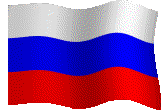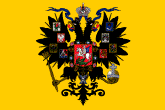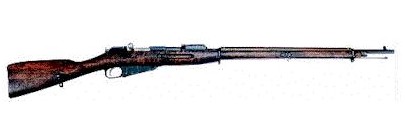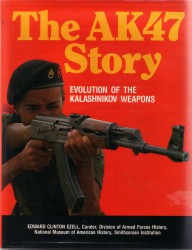CRUFFLER.COM
presents
FIREARM
REVIEW,
February
2000:
 |
 |
 |

Image Credit: The Russian Mosin Nagant Page http://home.eznet.net/~rwheel/imperial.htm |
Type:
Turnbolt Magazine Repeating Rifle
System of Operation: Bolt Action Caliber: 7.62x54mmR Capacity: 5 rounds Sights: Blade front, Elevation adjustable rear notch Length: 1318mm Weight (unloaded): 4.06kg Barrel: 760mm, 4 groove, right-hand twist |
The Russo-Turkish War of 1877-1878 inspired the Imperial Russian Army to search for a small caliber magazine repeating rifle. During that war, most of the Turkish forces were armed with either Peabody-Martini or Snider single shot rifles. However some of them were armed with .44-40 (.44 WCF or 11mm) Winchester Model 1873 lever action rifles. Despite the fact that these were comparatively short range rifles, the Russians were impressed with their high rate of fire.
As a result, the task of searching for a magazine repeating rifle was assigned to a unit of the Main Artillery Commission (Glavnoe artilleriiskoe upravlenie - GAU). In 1883, the GAU established a magazine rifle study and testing commission under the command of Lieutenant General N.I. Chagin.
Chagin's commission plodded along until 1887. Then, the Russian War Ministry began to receive reports about a variety of repeating rifle development programs in other countries. This gave a new direction to the Russian search as the foreign rifles were smaller in caliber and were not using the standard black powder loads. To the Russians' amazement the new smokeless gunpowder produced higher bullet velocities without the fouling problems of black powder. In response, the GAU repeating rifle commission hatched a plan for a repeating rifle development plan in 1888. Testing of the candidate rifles was to be conducted at the Russian Infantry Officers Training School at Oranienbaum.
The first round of tests, 1888 included the ten shot, side mounted magazine Ignatovich, the under barrel magazine Kvashneveskiy, as well as other magazine models by Lutkovskiy, Melkov, Mosin, Mauser, and Gras-Kropatschek. Two rifles made the early short list - the Lutkovskiy and the Mosin.
Captain Sergei Ivanovich Mosin's rifle was an evolutionary development of the Model 1870 Berdan II rifle. He had begun his experiments to improve the Berdan II in 1882, by placing an 8 shot magazine on the rifle's stock. In 1885 the GAU commission placed an order for one thousand 12 shot Mosin-Berdans for use in field testing by the Russian Army. For the next four years, Mosin continued to experiment with variations on 10.6mm rifles. In 1889, the GAU commission recommended the adoption of Mosin's best design, but was overruled by the War Ministry staff. As a result the search continued.
In the meantime, Mosin was developing a three lini (7.62mm) [a "lini" was an Imperial Russian unit of measure equating to about 0.1" - it has since been corrupted into "line"] rifle of a more modern design. His turnbolt, 5 shot model of 1890 was very highly regarded. At the same time, Leon Nagant of Liege, Belgium, presented his 3.5 lini (8mm) rifle to the GAU commission. Both Mosin's and Nagant's rifles were subjected to field tests by the Pavlovskiy Life Guards Regiment, the Izmailov Life Guards Regiment, the 147th Samara Regiment, and the Sharpshooter Battalion. Three hundred apiece of the Model 1870 Berdan and Model 1890 Mosin rifles were issued to the soldiers from these units, while one hundred Nagant rifles were issued. Mosin's rifle, with the Nagant designed magazine was selected as the best design.
There has been considerable historical controversy about the extent to which Leon Nagant was involved in the design of the Model 1891 rifle. Nagant had often visited St. Petersburg. In 1888 he was at the capital during the time discussions were being held concerning replacing the Berdan II rifle. However, most research seems to point to Mosin as the source for the majority of the ideas in the 1891. Overall, Nagant's key contribution seems to have been the magazine follower, the design of which prevents double feeding. This design had been incorporated into Nagant's Model 1888 rifle that had been tested by the Belgian Army. (This rifle was rejected in favor of the Mauser design that later became the Model 1889 Belgian Mauser. Nagant may have also influenced the bolt design to an extent, as well as the use of a charger clip to strip cartridges into the magazine.
The Russian
War Minister, P.S. Vannovskiy remarked that its design simplicity was one
of the major reasons for selecting the Mosin-Nagant rifle, as this would
help to keep unit cost low, and lend itself to rapid tooling up in the
Russian factories. It was with this that the Ministry of War recommended
the adoption of the new rifle to Tsar Alexander III in April, 1891.
The Tsar quickly approved this proposal, and the rifle was given the official
nomenclature trekhlinneioi vintovki obrazets 1891 goda (3 line 7.62x54mmR
rifle model 1891).
BIBLIOGRAPHY
Ezell, Edward C., The AK-47 Story, (Stackpole Books, Harrisburg, Pennsylvania: 1986)
The
AK-47 Story is available from IDSA Books. Click on the image
to order:

|
|